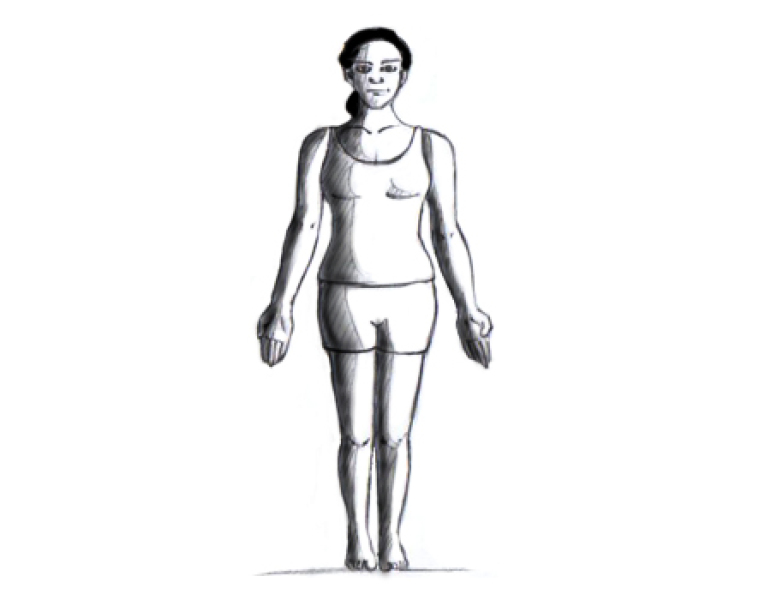
root as humus, earth. So too does humble,
of staying humble is to realize what
along to explain the minute details of how it
knew that our bodies are made from earth,


Morning Yoga: Wake Up!

Here are a few key poses that will get you moving in the morning…
Child’s Pose (Balasana): Draw your knees to the outside of your mat and bring your big toes together, grounding down through the tops of your feet. Sit back onto your heels, reach your arms forward, and melt your heart in between your thighs. Your forehead should come to the floor or to a block for support. Take a few deep breaths into the back side of your body and ground down through your fingertips. Melt your heart towards the floor with every exhalation. (5-10 breaths)

Cat-Cow (Marjaryasana- Bitilasana): Come to a table top position with hands underneath of your shoulders and knees underneath of your hips. Your feet shoot straight back behind your knees. Start with a flat back. Inhale, drop your belly, open your heart, draw your shoulder blades back, and gaze forward. Exhale, round your back and gaze to your belly button. Take a few rounds matching your breath with each movement and then return to a flat back. (5-10 breaths)

Downward Facing Dog (Adho Mukha Svanasana): From table top position, curl your toes under and lift your hips up into the sky. Work your heels down towards or to the mat. Draw your head in between your biceps, hug in your triceps, and spread your fingers wide. Keep lifting your tailbone as you draw in your lower ribs. Take a few moments to pedal out your legs. It is the morning, so you’re going to be a bit tight. Be patient with your body. (5 breaths)

Forward Fold (Uttanasana): From Down Dog, slowly begin to walk your feet to the top of your mat. Separate your feet a bit and hang over your legs. Make sure you have soft knees and that you are completely releasing your neck. You can sway side to side and release into the posture with every exhalation. (5 breaths)

Mountain (Tadasana): From your forward fold, slowly begin to roll up to standing, stacking one vertebrae at a time. Your head comes up last. Toe-heel your feet together, bring your arms to your sides, and open the palms for the front of the room. Ground down through your feet, lift up your knee caps, slightly tug your tailbone, draw in belly button to spine, and relax your shoulder blades down your back.

Take time to notice your body in each of these postures. It takes time and practice to become aware of how our bodies feel in each pose. Always feel free to make modifications too. It’s your practice! Enjoy!
Namaste,
Sarah

“There is the mud, and there is the lotus that grows out of the mud. We need the mud in order to make the lotus.”
Thich Nhat Hanh

While I do love the occasional cup of coffee, I have found that drinking tea can greatly benefit your health. Tea is packed full with antioxidants and phytochemicals, which is why it has such a long list of benefits. It has been used for centuries as a form of alternative medicine for ailments ranging from a stomachache to Alzheimer’s. So take your pick….
There are four key types of teas, green, black, white, and oolong. Try them all or a combination that fits you. For instance, yerba mate and white teas can aid in weight loss, while green tea has been shown to be effective in fighting cancer. Go beyond the key four teas and try some tea with ginger, which has anti-inflammatory effects. Also, mix your tea with some lemon. I have been a proponent of drinking warm lemon water in the morning for it’s detoxification effects on the body, so trying mixing in some tea once in a while.
Guayusa tea- I recently discovered this tea and it is a great alternative to some of the classics. Guayusa is a tree leaf from the Amazon and has been used by its natives for thousands of years. It has properties similar to those of green tea and is also filled with antioxidants. It does contain caffeine, which provides energy, but it has a more subtle effect minus the jitters. Think of it as coffee of the Amazon!
Morning Practice: Do you practice yoga in the morning? Try drinking warm tea with lemon before you practice and before you eat breakfast. Your body will wake up with more ease and will be ready for the day.
Namaste,
Sarah












Feel free to add additional organic fruits, stevia, or agave to sweeten
Enjoy!

Eight Limbs of Yoga
If you go to a yoga class, you may hear about the “eight limbs” or eightfold path of yoga. This comes from Patanjali’s Yoga Sutras. Centuries ago, Patanjali was a great sage who compiled this essential guide/ foundational text of yoga principles. Within the Yoga Sutras, Patanjali describes this eightfold path for moral and ethical conduct towards oneself and others.
Yoga is more than just a physical practice “Asana”, which is only one of the eight limbs. By practicing yoga, you slowly become aware of how to take care of your body/ mind and how you treat those around you. The Yoga Sutras were originally written in Sanskrit and there are many translations, but if you look at the core principles, they are actually very practical.
Take a few minutes each day to sit and meditate with each of these limbs. And remember, when reading about the limbs, especially the yamas and the niyamas, keep an open mind and don’t take the concepts so literally. Try to interpret the limbs and apply them to your life. It’s about being disciplined in how you treat yourself and those around you. The power and capacity within each individual can seem to be beyond comprehension. Therefore, the Yoga Sutras are a wonderful guide in moving towards that potential.
1. Yamas– how we behave in life and towards those around us
Ahimsa– nonviolence; being kind to all beings
Satya– truthfulness; “speaking your truth” (while still keeping in mind Ahimsa)
Asteya– nonstealing; not just the act of not stealing but the mental intentions/desires that we cultivate in our minds
Brahmacharya– continence “don’t take this too literally” 🙂
Aparigraha– non-hoarding; non-greediness; to own only what is necessary
2. Niyamas– self-discipline
Saucha– cleanliness; taking care and purifying your body
Samtosha– contentment; being content with things in the present moment
Tapas– heat “physical practice”; cleansing the body and mind through practice/ exercise
Svadhyaya– self study “examining yourself and the world”; journaling/reading
Isvarapranidhana– surrender to the universe, God, whom or whatever you believe in…or surrendering yourself to life if you choose…it’s really about simply letting go
3. Asana– disciplined physical practice “your body is a temple”
4. Pranayama– breath control; pranayama translates to “life force extension”; learning proper breathing rejuvenates your body and enhances your life
5. Pratyahara– withdrawing of the senses; moving towards meditation, we begin to transfer our awareness from the outside world to our internal self
6. Dharana– concentration on a single point; now moving away from the internal distractions of the mind
7. Dhyana– meditation; ultimate state of awareness without focus; state of stillness and contemplation (all of the previous limbs prepare for this state of meditation)
8. Samadhi– bliss; transcendence of the self; becoming one with the universe/ divine/ however you define it
~ Again take time to look into these limbs and determine how you can apply them to your life. While yoga can be a spiritual practice for some, it is not a religion. Yoga is a way of living and acting. You can define it for yourself. That is the beauty of the practice. ~
Namaste,
Sarah